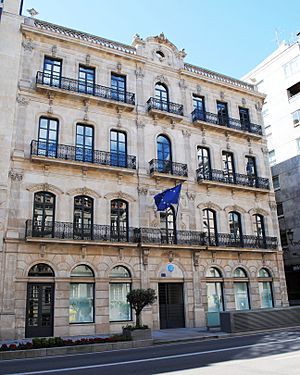European Fisheries Control Agency facts for kids
 |
|
 The Odriozola building, housing the EFCA's headquarters |
|
| Agency overview | |
|---|---|
| Formed | 1 February 2006 |
| Preceding |
|
| Jurisdiction | European Union |
| Headquarters | Vigo, Spain |
| Employees | 104 |
| Agency executive |
|
| Key document |
|

The European Fisheries Control Agency (EFCA) is a special agency of the European Union (EU). Its main job is to help EU countries work together to control fishing. EFCA makes sure that fishing rules, called the Common Fisheries Policy (CFP), are followed. This agency is located in Vigo, Spain.
Contents
History of the EFCA
The EFCA started as the Community Fisheries Control Agency (CFCA). It was officially created on April 26, 2005. The agency's first main meeting happened on February 1, 2006.
On January 1, 2012, the agency changed its name. It became the European Fisheries Control Agency, or EFCA. The rules for the agency were updated in 2019.
What EFCA Does: Mission and Goals
EFCA's main goal is to make sure fishing rules are followed. It wants all EU countries to use the same high standards for checking fishing boats. This helps keep fishing fair and sustainable.
EFCA helps EU countries and the European Commission. It helps them work together on fishing checks. The agency also trains people who inspect fishing activities. This makes sure that the Common Fisheries Policy (CFP) rules are used correctly everywhere.
The agency helps create a fair playing field for all fishers. It also helps protect fish populations for the future. This means there will be enough fish for everyone, now and later.
EFCA also works with other agencies. These include the European Border and Coast Guard Agency and the European Maritime Safety Agency. Together, they support countries in their coast guard duties.
How EFCA is Organized
The Administrative Board
EFCA is guided by a group called the Administrative Board. This board includes six people from the European Commission. It also has one person from each EU country. An Executive Director manages the agency day-to-day.
The board decides what EFCA will focus on. It approves the agency's budget after the European Parliament and the Council agree. The board also chooses the Executive Director.
Board members are chosen for five years and can serve again. They are experts in fishing control. The board picks a chairperson and a deputy for three years. They usually meet twice a year.
The Executive Director runs EFCA's daily activities. They create the yearly budget and work plan. The Executive Director reports to the Administrative Board. This person is also chosen for a five-year term.
The Advisory Board
The Advisory Board gives advice to EFCA's Executive Director. This board helps EFCA work closely with people involved in fishing. It is made up of representatives from different advisory councils.
A member from the Advisory Board can attend Administrative Board meetings. They can share ideas but do not vote. This representative changes each year.
Advisory councils are groups with people from the fishing industry. They also include other interested groups. These councils give advice to the European Commission and EU countries. They help with how fishing is managed.
Here are some of the advisory councils:
- Baltic Sea Advisory Council (BSAC)
- South Western Waters Advisory Council (SWWAC)
- Long Distance Advisory Council (LDAC)
- Mediterranean Advisory Council (MEDAC)
- Pelagic Advisory Council (Pelagic AC)
- North Western Waters Advisory Council (NWWAC)
- North Sea Advisory Council (NSAC)
EFCA's Activities
Working in the EU
EFCA helps coordinate fishing checks on land and at sea. This is done through "joint deployment plans" (JDPs). These plans bring together people and equipment from different EU countries. EFCA helps manage these shared resources.
Each EU country is responsible for enforcing fishing rules in its own waters. EFCA helps countries work together. It makes sure that fishing laws are applied in the same way everywhere.
Working Internationally
EFCA also helps the EU with fishing outside its borders. It helps fight against Illegal, Unreported, and Unregulated (IUU) fishing. IUU fishing is when people fish without permission or break the rules.
EFCA helps the EU work with other countries and international fishing groups. This helps improve fishing control around the world.
Sometimes, the EU has fishing agreements with countries outside Europe. EFCA can help these countries learn how to control fishing better.
EFCA also helps EU countries follow rules against IUU fishing. It organizes workshops and helps the European Commission check other countries.
In 2016, EFCA helped with almost 19,500 fishing inspections. These checks found 665 possible rule violations.
EFCA's Pennant
Image:Pennant of the European Union Fishery Inspection.svg Even though the EU doesn't have a regular flag for its fishing inspection teams, they use a special pennant. A pennant is a long, narrow flag. This pennant is blue and yellow and is flown on inspection vessels in EU waters. It is a triangular flag with blue and yellow sections. There are no other versions of this flag.
See also
 In Spanish: Agencia Europea de Control de la Pesca para niños
In Spanish: Agencia Europea de Control de la Pesca para niños
- European Commissioner for Maritime Affairs and Fisheries
- Directorate-General for Maritime Affairs and Fisheries
- Agriculture and Fisheries Council (Council of the European Union)
- Directorate-General for Agriculture, Fisheries, Social Affairs and Health
- European Parliament Committee on Fisheries

